Economic and Social Sustainability: Environmental Impact Essay
VerifiedAdded on 2021/04/21
|11
|2804
|75
Essay
AI Summary
This essay provides a critical evaluation of economic, social, and environmental sustainability, emphasizing the importance of managing environmental impacts for a sustainable future. It explores the concepts of social sustainability, highlighting the role of environmental laws and human rights. The essay also delves into economic sustainability, discussing the maintenance of economic welfare and the significance of natural capital. Furthermore, it examines environmental sustainability, focusing on the functions of environmental resources and the impact of unsustainable practices. The essay also establishes a link between trade, public debt, and resource depletion for small open nations. The conclusion reinforces the necessity of environmental sustainability for both economic and social well-being, advocating for enhanced environmental laws and practices.
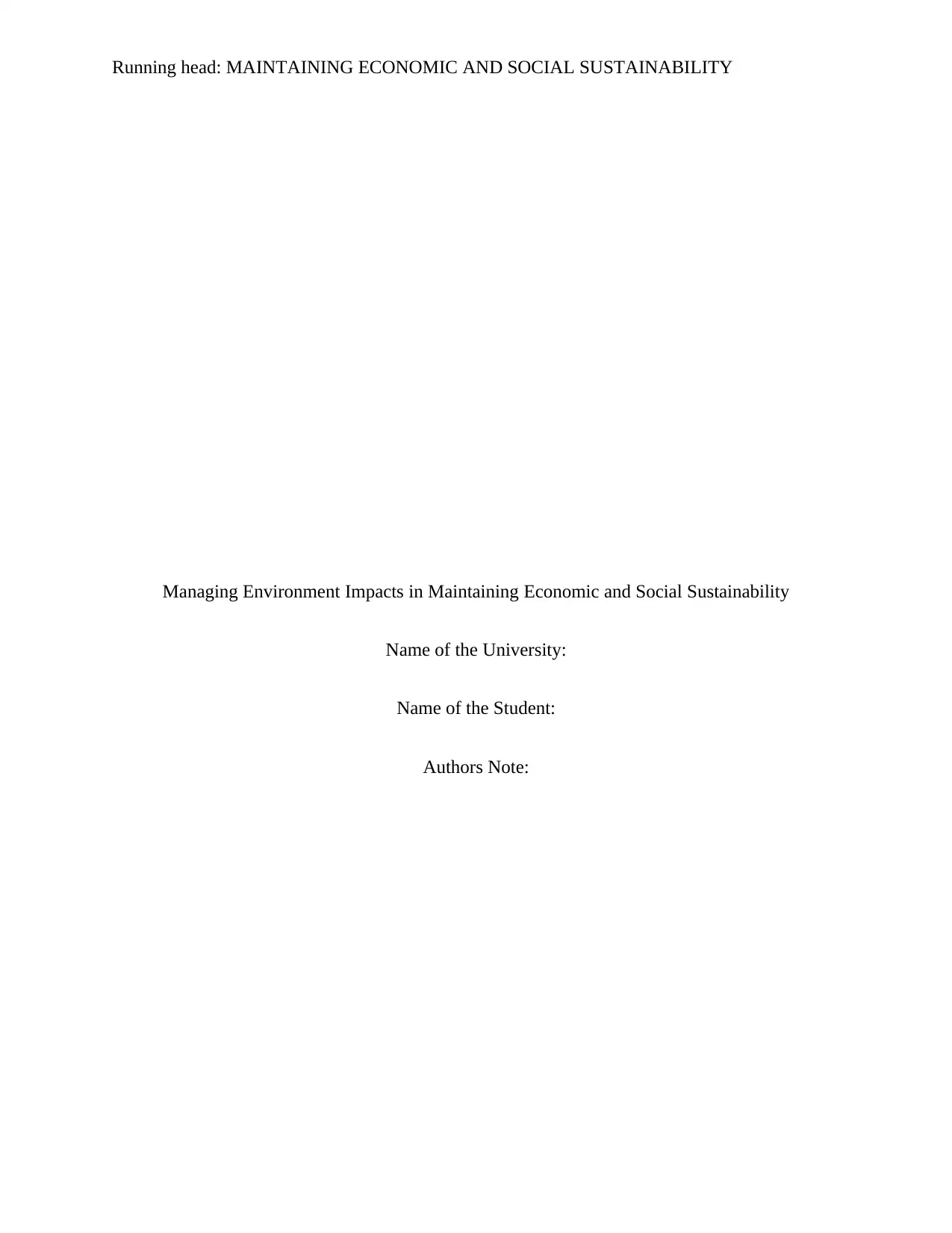
Running head: MAINTAINING ECONOMIC AND SOCIAL SUSTAINABILITY
Managing Environment Impacts in Maintaining Economic and Social Sustainability
Name of the University:
Name of the Student:
Authors Note:
Managing Environment Impacts in Maintaining Economic and Social Sustainability
Name of the University:
Name of the Student:
Authors Note:
Paraphrase This Document
Need a fresh take? Get an instant paraphrase of this document with our AI Paraphraser
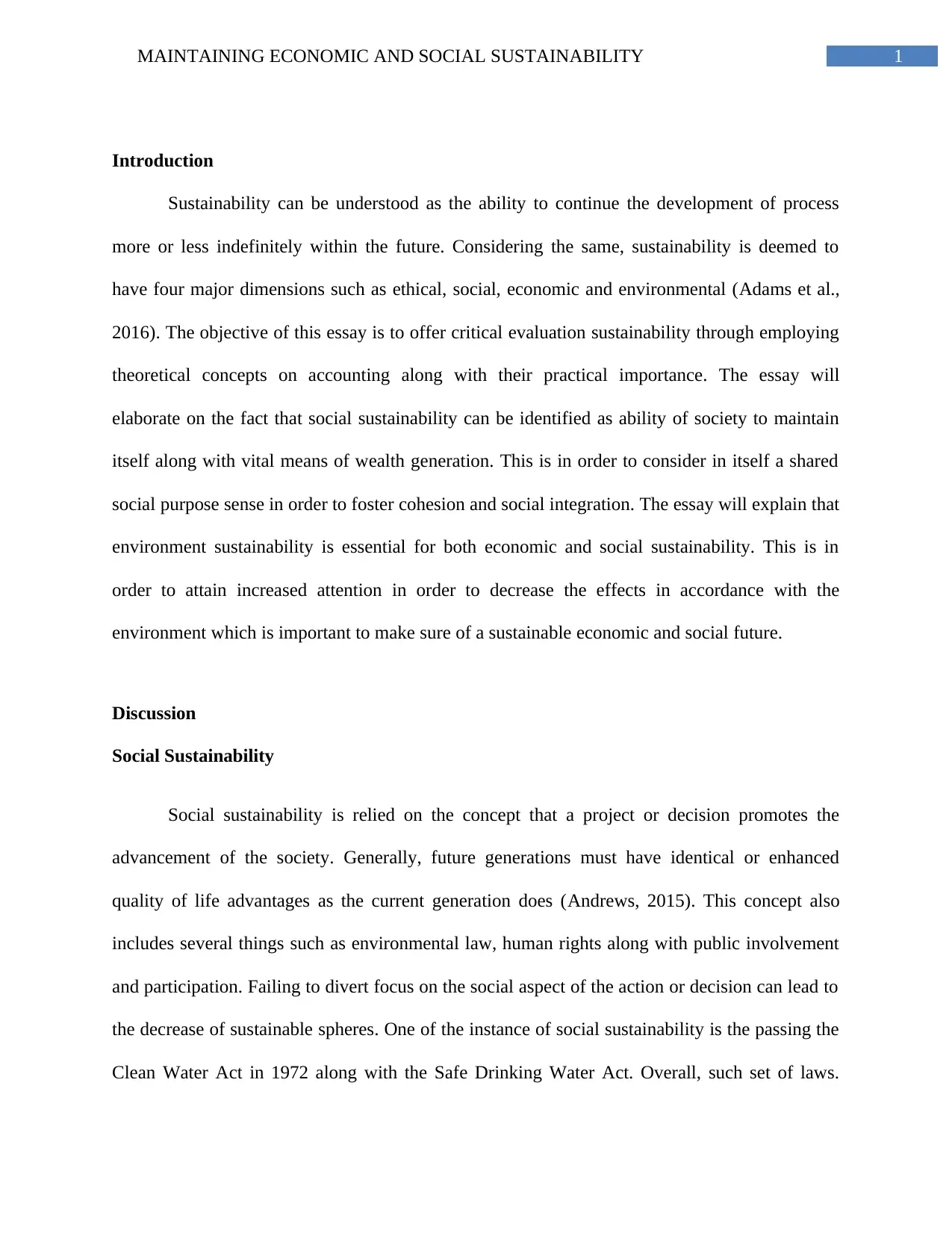
1MAINTAINING ECONOMIC AND SOCIAL SUSTAINABILITY
Introduction
Sustainability can be understood as the ability to continue the development of process
more or less indefinitely within the future. Considering the same, sustainability is deemed to
have four major dimensions such as ethical, social, economic and environmental (Adams et al.,
2016). The objective of this essay is to offer critical evaluation sustainability through employing
theoretical concepts on accounting along with their practical importance. The essay will
elaborate on the fact that social sustainability can be identified as ability of society to maintain
itself along with vital means of wealth generation. This is in order to consider in itself a shared
social purpose sense in order to foster cohesion and social integration. The essay will explain that
environment sustainability is essential for both economic and social sustainability. This is in
order to attain increased attention in order to decrease the effects in accordance with the
environment which is important to make sure of a sustainable economic and social future.
Discussion
Social Sustainability
Social sustainability is relied on the concept that a project or decision promotes the
advancement of the society. Generally, future generations must have identical or enhanced
quality of life advantages as the current generation does (Andrews, 2015). This concept also
includes several things such as environmental law, human rights along with public involvement
and participation. Failing to divert focus on the social aspect of the action or decision can lead to
the decrease of sustainable spheres. One of the instance of social sustainability is the passing the
Clean Water Act in 1972 along with the Safe Drinking Water Act. Overall, such set of laws.
Introduction
Sustainability can be understood as the ability to continue the development of process
more or less indefinitely within the future. Considering the same, sustainability is deemed to
have four major dimensions such as ethical, social, economic and environmental (Adams et al.,
2016). The objective of this essay is to offer critical evaluation sustainability through employing
theoretical concepts on accounting along with their practical importance. The essay will
elaborate on the fact that social sustainability can be identified as ability of society to maintain
itself along with vital means of wealth generation. This is in order to consider in itself a shared
social purpose sense in order to foster cohesion and social integration. The essay will explain that
environment sustainability is essential for both economic and social sustainability. This is in
order to attain increased attention in order to decrease the effects in accordance with the
environment which is important to make sure of a sustainable economic and social future.
Discussion
Social Sustainability
Social sustainability is relied on the concept that a project or decision promotes the
advancement of the society. Generally, future generations must have identical or enhanced
quality of life advantages as the current generation does (Andrews, 2015). This concept also
includes several things such as environmental law, human rights along with public involvement
and participation. Failing to divert focus on the social aspect of the action or decision can lead to
the decrease of sustainable spheres. One of the instance of social sustainability is the passing the
Clean Water Act in 1972 along with the Safe Drinking Water Act. Overall, such set of laws.
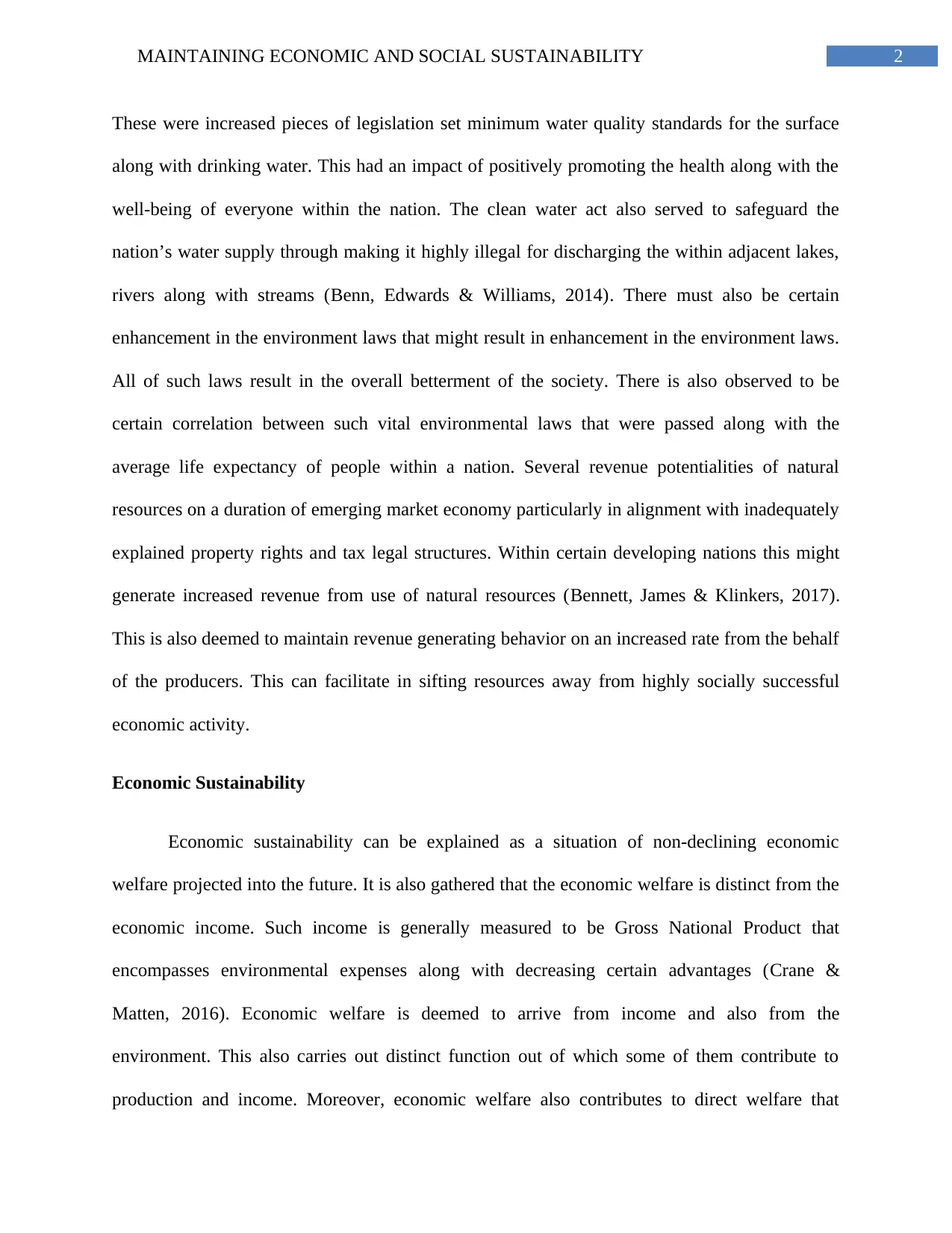
2MAINTAINING ECONOMIC AND SOCIAL SUSTAINABILITY
These were increased pieces of legislation set minimum water quality standards for the surface
along with drinking water. This had an impact of positively promoting the health along with the
well-being of everyone within the nation. The clean water act also served to safeguard the
nation’s water supply through making it highly illegal for discharging the within adjacent lakes,
rivers along with streams (Benn, Edwards & Williams, 2014). There must also be certain
enhancement in the environment laws that might result in enhancement in the environment laws.
All of such laws result in the overall betterment of the society. There is also observed to be
certain correlation between such vital environmental laws that were passed along with the
average life expectancy of people within a nation. Several revenue potentialities of natural
resources on a duration of emerging market economy particularly in alignment with inadequately
explained property rights and tax legal structures. Within certain developing nations this might
generate increased revenue from use of natural resources (Bennett, James & Klinkers, 2017).
This is also deemed to maintain revenue generating behavior on an increased rate from the behalf
of the producers. This can facilitate in sifting resources away from highly socially successful
economic activity.
Economic Sustainability
Economic sustainability can be explained as a situation of non-declining economic
welfare projected into the future. It is also gathered that the economic welfare is distinct from the
economic income. Such income is generally measured to be Gross National Product that
encompasses environmental expenses along with decreasing certain advantages (Crane &
Matten, 2016). Economic welfare is deemed to arrive from income and also from the
environment. This also carries out distinct function out of which some of them contribute to
production and income. Moreover, economic welfare also contributes to direct welfare that
These were increased pieces of legislation set minimum water quality standards for the surface
along with drinking water. This had an impact of positively promoting the health along with the
well-being of everyone within the nation. The clean water act also served to safeguard the
nation’s water supply through making it highly illegal for discharging the within adjacent lakes,
rivers along with streams (Benn, Edwards & Williams, 2014). There must also be certain
enhancement in the environment laws that might result in enhancement in the environment laws.
All of such laws result in the overall betterment of the society. There is also observed to be
certain correlation between such vital environmental laws that were passed along with the
average life expectancy of people within a nation. Several revenue potentialities of natural
resources on a duration of emerging market economy particularly in alignment with inadequately
explained property rights and tax legal structures. Within certain developing nations this might
generate increased revenue from use of natural resources (Bennett, James & Klinkers, 2017).
This is also deemed to maintain revenue generating behavior on an increased rate from the behalf
of the producers. This can facilitate in sifting resources away from highly socially successful
economic activity.
Economic Sustainability
Economic sustainability can be explained as a situation of non-declining economic
welfare projected into the future. It is also gathered that the economic welfare is distinct from the
economic income. Such income is generally measured to be Gross National Product that
encompasses environmental expenses along with decreasing certain advantages (Crane &
Matten, 2016). Economic welfare is deemed to arrive from income and also from the
environment. This also carries out distinct function out of which some of them contribute to
production and income. Moreover, economic welfare also contributes to direct welfare that
⊘ This is a preview!⊘
Do you want full access?
Subscribe today to unlock all pages.

Trusted by 1+ million students worldwide
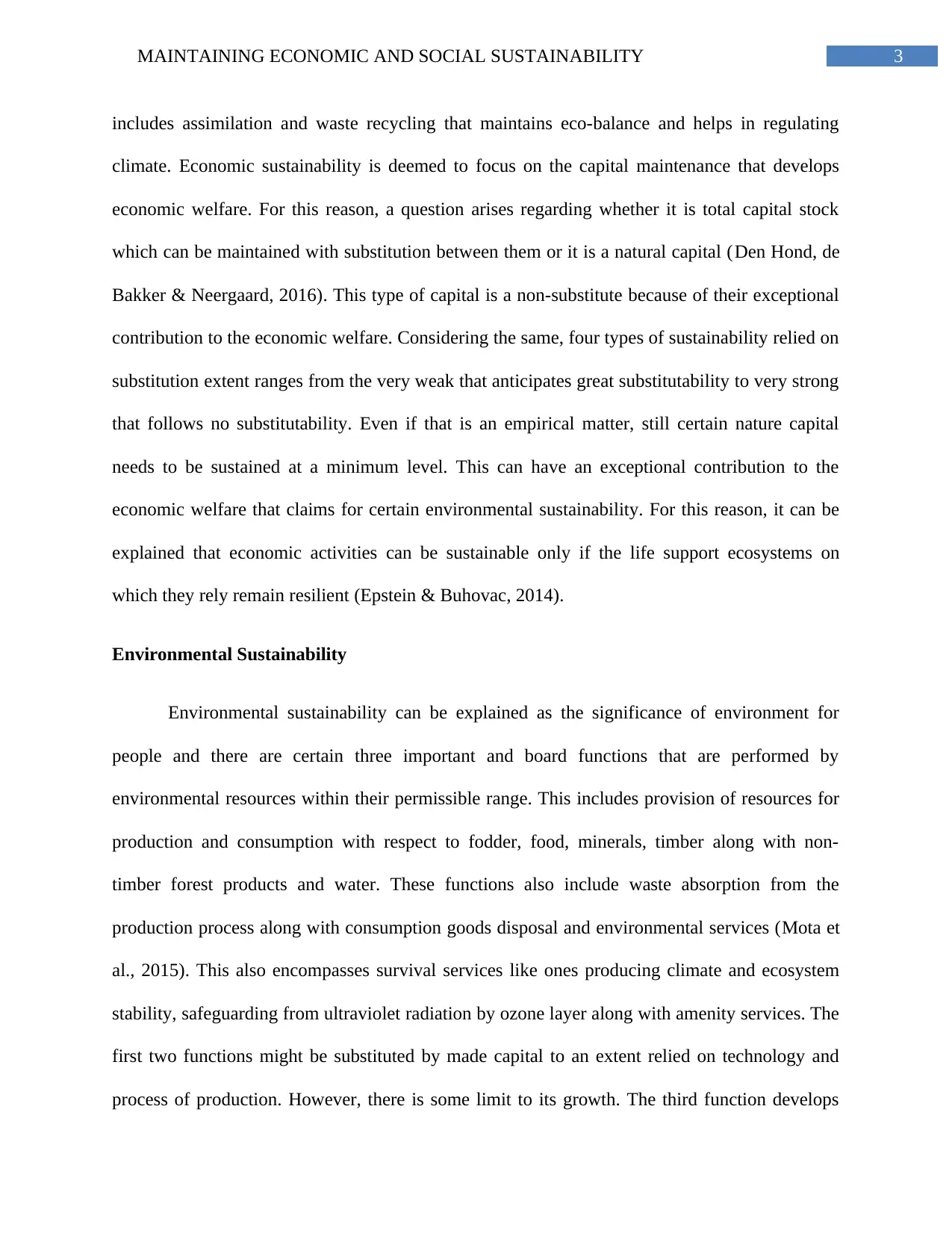
3MAINTAINING ECONOMIC AND SOCIAL SUSTAINABILITY
includes assimilation and waste recycling that maintains eco-balance and helps in regulating
climate. Economic sustainability is deemed to focus on the capital maintenance that develops
economic welfare. For this reason, a question arises regarding whether it is total capital stock
which can be maintained with substitution between them or it is a natural capital (Den Hond, de
Bakker & Neergaard, 2016). This type of capital is a non-substitute because of their exceptional
contribution to the economic welfare. Considering the same, four types of sustainability relied on
substitution extent ranges from the very weak that anticipates great substitutability to very strong
that follows no substitutability. Even if that is an empirical matter, still certain nature capital
needs to be sustained at a minimum level. This can have an exceptional contribution to the
economic welfare that claims for certain environmental sustainability. For this reason, it can be
explained that economic activities can be sustainable only if the life support ecosystems on
which they rely remain resilient (Epstein & Buhovac, 2014).
Environmental Sustainability
Environmental sustainability can be explained as the significance of environment for
people and there are certain three important and board functions that are performed by
environmental resources within their permissible range. This includes provision of resources for
production and consumption with respect to fodder, food, minerals, timber along with non-
timber forest products and water. These functions also include waste absorption from the
production process along with consumption goods disposal and environmental services (Mota et
al., 2015). This also encompasses survival services like ones producing climate and ecosystem
stability, safeguarding from ultraviolet radiation by ozone layer along with amenity services. The
first two functions might be substituted by made capital to an extent relied on technology and
process of production. However, there is some limit to its growth. The third function develops
includes assimilation and waste recycling that maintains eco-balance and helps in regulating
climate. Economic sustainability is deemed to focus on the capital maintenance that develops
economic welfare. For this reason, a question arises regarding whether it is total capital stock
which can be maintained with substitution between them or it is a natural capital (Den Hond, de
Bakker & Neergaard, 2016). This type of capital is a non-substitute because of their exceptional
contribution to the economic welfare. Considering the same, four types of sustainability relied on
substitution extent ranges from the very weak that anticipates great substitutability to very strong
that follows no substitutability. Even if that is an empirical matter, still certain nature capital
needs to be sustained at a minimum level. This can have an exceptional contribution to the
economic welfare that claims for certain environmental sustainability. For this reason, it can be
explained that economic activities can be sustainable only if the life support ecosystems on
which they rely remain resilient (Epstein & Buhovac, 2014).
Environmental Sustainability
Environmental sustainability can be explained as the significance of environment for
people and there are certain three important and board functions that are performed by
environmental resources within their permissible range. This includes provision of resources for
production and consumption with respect to fodder, food, minerals, timber along with non-
timber forest products and water. These functions also include waste absorption from the
production process along with consumption goods disposal and environmental services (Mota et
al., 2015). This also encompasses survival services like ones producing climate and ecosystem
stability, safeguarding from ultraviolet radiation by ozone layer along with amenity services. The
first two functions might be substituted by made capital to an extent relied on technology and
process of production. However, there is some limit to its growth. The third function develops
Paraphrase This Document
Need a fresh take? Get an instant paraphrase of this document with our AI Paraphraser
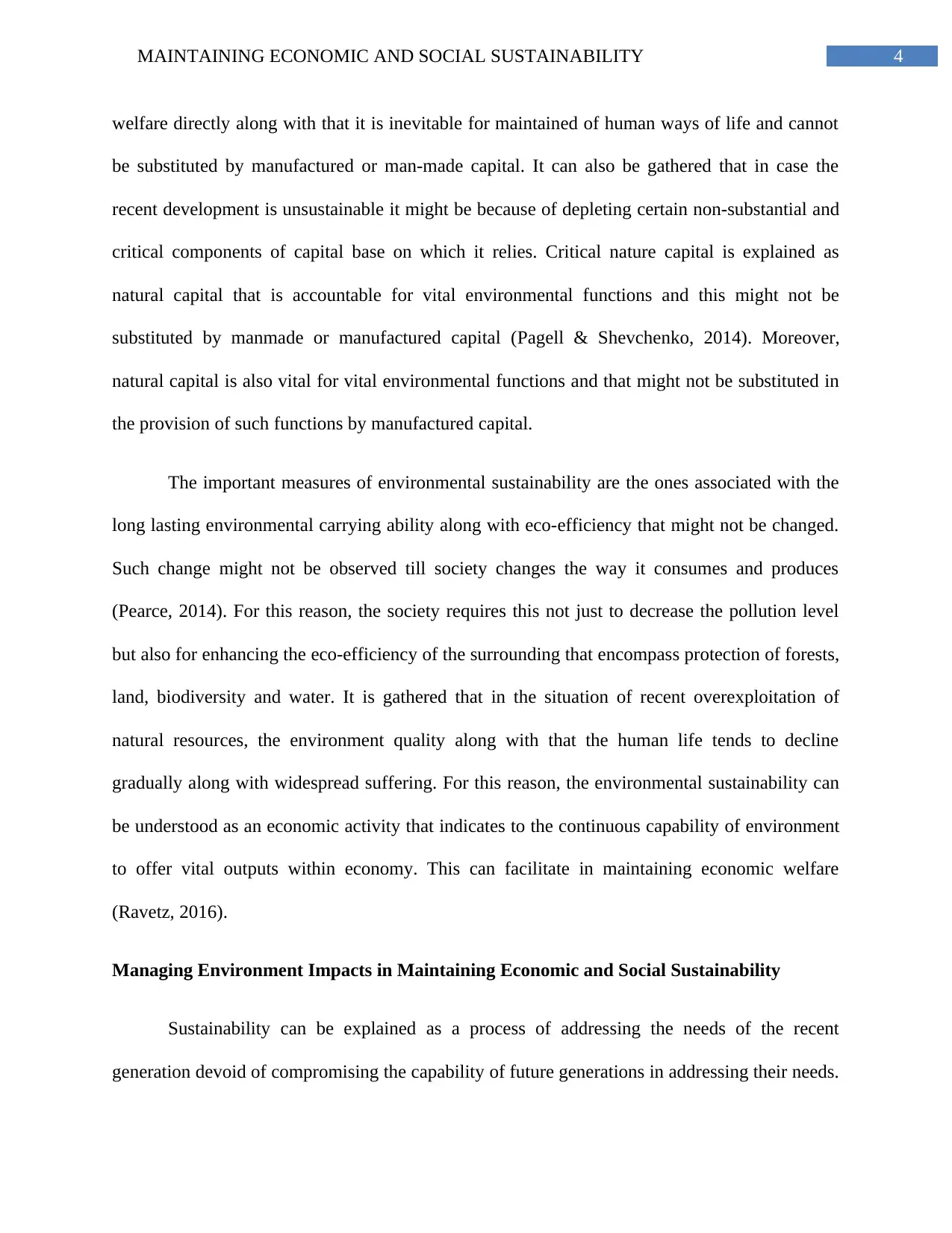
4MAINTAINING ECONOMIC AND SOCIAL SUSTAINABILITY
welfare directly along with that it is inevitable for maintained of human ways of life and cannot
be substituted by manufactured or man-made capital. It can also be gathered that in case the
recent development is unsustainable it might be because of depleting certain non-substantial and
critical components of capital base on which it relies. Critical nature capital is explained as
natural capital that is accountable for vital environmental functions and this might not be
substituted by manmade or manufactured capital (Pagell & Shevchenko, 2014). Moreover,
natural capital is also vital for vital environmental functions and that might not be substituted in
the provision of such functions by manufactured capital.
The important measures of environmental sustainability are the ones associated with the
long lasting environmental carrying ability along with eco-efficiency that might not be changed.
Such change might not be observed till society changes the way it consumes and produces
(Pearce, 2014). For this reason, the society requires this not just to decrease the pollution level
but also for enhancing the eco-efficiency of the surrounding that encompass protection of forests,
land, biodiversity and water. It is gathered that in the situation of recent overexploitation of
natural resources, the environment quality along with that the human life tends to decline
gradually along with widespread suffering. For this reason, the environmental sustainability can
be understood as an economic activity that indicates to the continuous capability of environment
to offer vital outputs within economy. This can facilitate in maintaining economic welfare
(Ravetz, 2016).
Managing Environment Impacts in Maintaining Economic and Social Sustainability
Sustainability can be explained as a process of addressing the needs of the recent
generation devoid of compromising the capability of future generations in addressing their needs.
welfare directly along with that it is inevitable for maintained of human ways of life and cannot
be substituted by manufactured or man-made capital. It can also be gathered that in case the
recent development is unsustainable it might be because of depleting certain non-substantial and
critical components of capital base on which it relies. Critical nature capital is explained as
natural capital that is accountable for vital environmental functions and this might not be
substituted by manmade or manufactured capital (Pagell & Shevchenko, 2014). Moreover,
natural capital is also vital for vital environmental functions and that might not be substituted in
the provision of such functions by manufactured capital.
The important measures of environmental sustainability are the ones associated with the
long lasting environmental carrying ability along with eco-efficiency that might not be changed.
Such change might not be observed till society changes the way it consumes and produces
(Pearce, 2014). For this reason, the society requires this not just to decrease the pollution level
but also for enhancing the eco-efficiency of the surrounding that encompass protection of forests,
land, biodiversity and water. It is gathered that in the situation of recent overexploitation of
natural resources, the environment quality along with that the human life tends to decline
gradually along with widespread suffering. For this reason, the environmental sustainability can
be understood as an economic activity that indicates to the continuous capability of environment
to offer vital outputs within economy. This can facilitate in maintaining economic welfare
(Ravetz, 2016).
Managing Environment Impacts in Maintaining Economic and Social Sustainability
Sustainability can be explained as a process of addressing the needs of the recent
generation devoid of compromising the capability of future generations in addressing their needs.
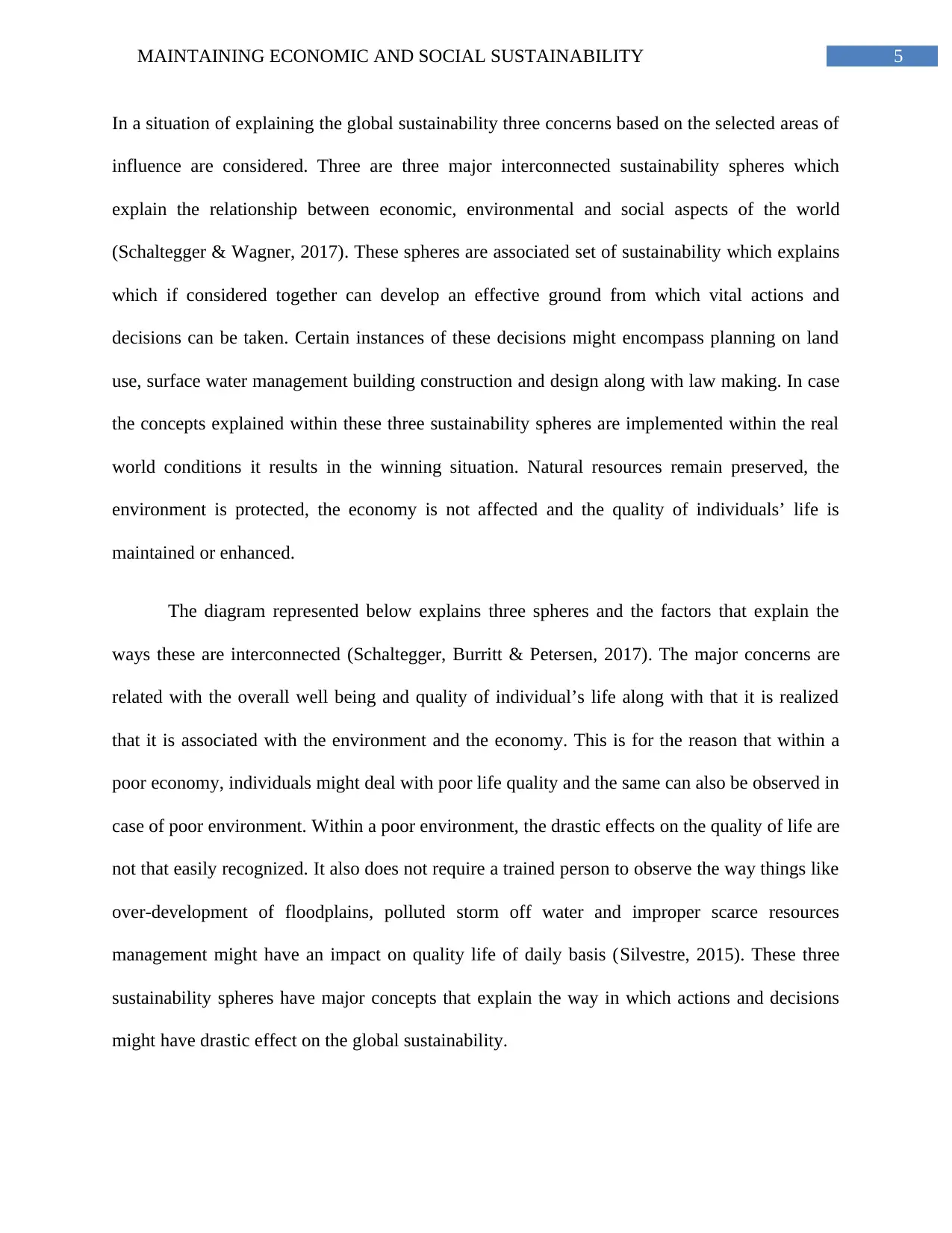
5MAINTAINING ECONOMIC AND SOCIAL SUSTAINABILITY
In a situation of explaining the global sustainability three concerns based on the selected areas of
influence are considered. Three are three major interconnected sustainability spheres which
explain the relationship between economic, environmental and social aspects of the world
(Schaltegger & Wagner, 2017). These spheres are associated set of sustainability which explains
which if considered together can develop an effective ground from which vital actions and
decisions can be taken. Certain instances of these decisions might encompass planning on land
use, surface water management building construction and design along with law making. In case
the concepts explained within these three sustainability spheres are implemented within the real
world conditions it results in the winning situation. Natural resources remain preserved, the
environment is protected, the economy is not affected and the quality of individuals’ life is
maintained or enhanced.
The diagram represented below explains three spheres and the factors that explain the
ways these are interconnected (Schaltegger, Burritt & Petersen, 2017). The major concerns are
related with the overall well being and quality of individual’s life along with that it is realized
that it is associated with the environment and the economy. This is for the reason that within a
poor economy, individuals might deal with poor life quality and the same can also be observed in
case of poor environment. Within a poor environment, the drastic effects on the quality of life are
not that easily recognized. It also does not require a trained person to observe the way things like
over-development of floodplains, polluted storm off water and improper scarce resources
management might have an impact on quality life of daily basis (Silvestre, 2015). These three
sustainability spheres have major concepts that explain the way in which actions and decisions
might have drastic effect on the global sustainability.
In a situation of explaining the global sustainability three concerns based on the selected areas of
influence are considered. Three are three major interconnected sustainability spheres which
explain the relationship between economic, environmental and social aspects of the world
(Schaltegger & Wagner, 2017). These spheres are associated set of sustainability which explains
which if considered together can develop an effective ground from which vital actions and
decisions can be taken. Certain instances of these decisions might encompass planning on land
use, surface water management building construction and design along with law making. In case
the concepts explained within these three sustainability spheres are implemented within the real
world conditions it results in the winning situation. Natural resources remain preserved, the
environment is protected, the economy is not affected and the quality of individuals’ life is
maintained or enhanced.
The diagram represented below explains three spheres and the factors that explain the
ways these are interconnected (Schaltegger, Burritt & Petersen, 2017). The major concerns are
related with the overall well being and quality of individual’s life along with that it is realized
that it is associated with the environment and the economy. This is for the reason that within a
poor economy, individuals might deal with poor life quality and the same can also be observed in
case of poor environment. Within a poor environment, the drastic effects on the quality of life are
not that easily recognized. It also does not require a trained person to observe the way things like
over-development of floodplains, polluted storm off water and improper scarce resources
management might have an impact on quality life of daily basis (Silvestre, 2015). These three
sustainability spheres have major concepts that explain the way in which actions and decisions
might have drastic effect on the global sustainability.
⊘ This is a preview!⊘
Do you want full access?
Subscribe today to unlock all pages.

Trusted by 1+ million students worldwide
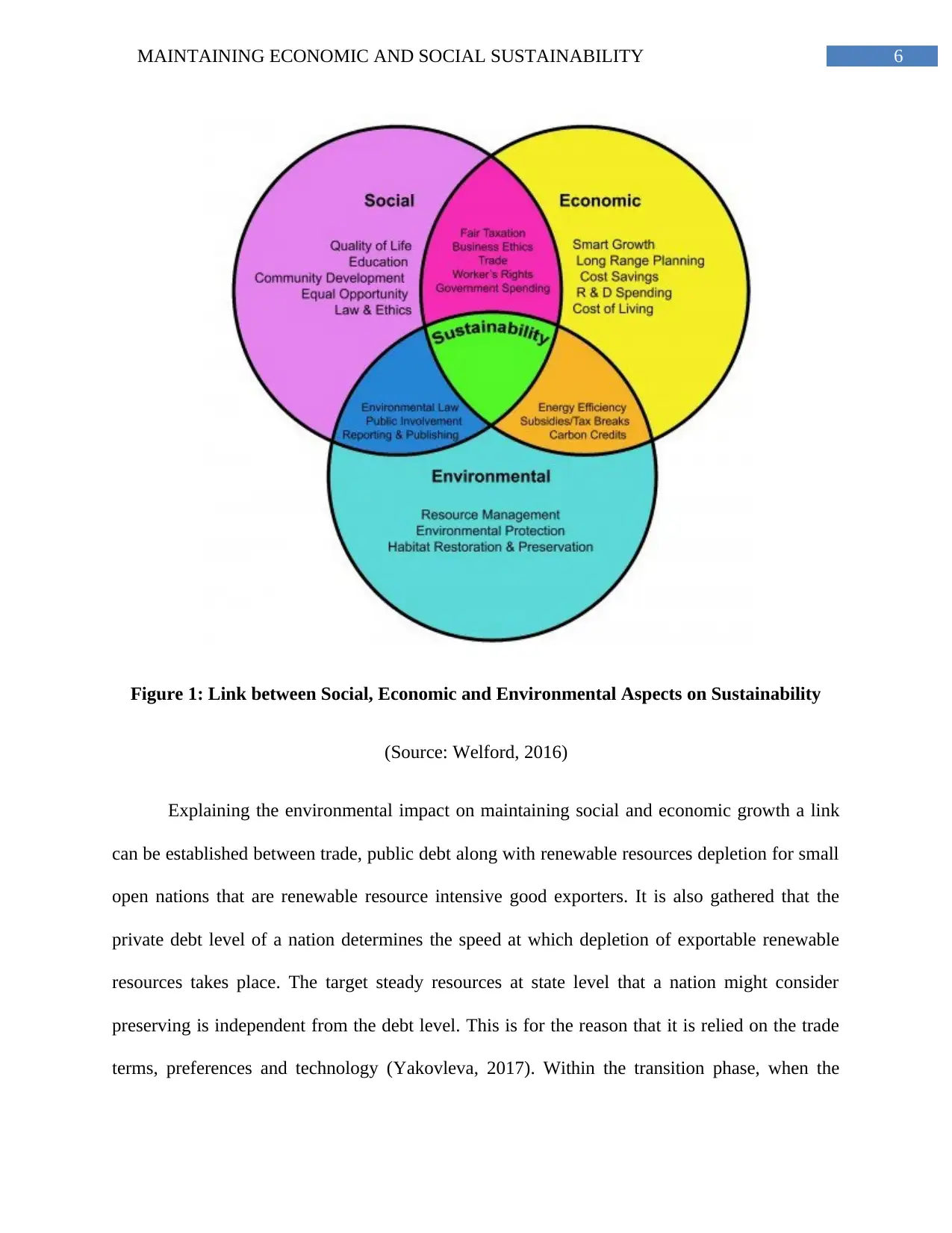
6MAINTAINING ECONOMIC AND SOCIAL SUSTAINABILITY
Figure 1: Link between Social, Economic and Environmental Aspects on Sustainability
(Source: Welford, 2016)
Explaining the environmental impact on maintaining social and economic growth a link
can be established between trade, public debt along with renewable resources depletion for small
open nations that are renewable resource intensive good exporters. It is also gathered that the
private debt level of a nation determines the speed at which depletion of exportable renewable
resources takes place. The target steady resources at state level that a nation might consider
preserving is independent from the debt level. This is for the reason that it is relied on the trade
terms, preferences and technology (Yakovleva, 2017). Within the transition phase, when the
Figure 1: Link between Social, Economic and Environmental Aspects on Sustainability
(Source: Welford, 2016)
Explaining the environmental impact on maintaining social and economic growth a link
can be established between trade, public debt along with renewable resources depletion for small
open nations that are renewable resource intensive good exporters. It is also gathered that the
private debt level of a nation determines the speed at which depletion of exportable renewable
resources takes place. The target steady resources at state level that a nation might consider
preserving is independent from the debt level. This is for the reason that it is relied on the trade
terms, preferences and technology (Yakovleva, 2017). Within the transition phase, when the
Paraphrase This Document
Need a fresh take? Get an instant paraphrase of this document with our AI Paraphraser
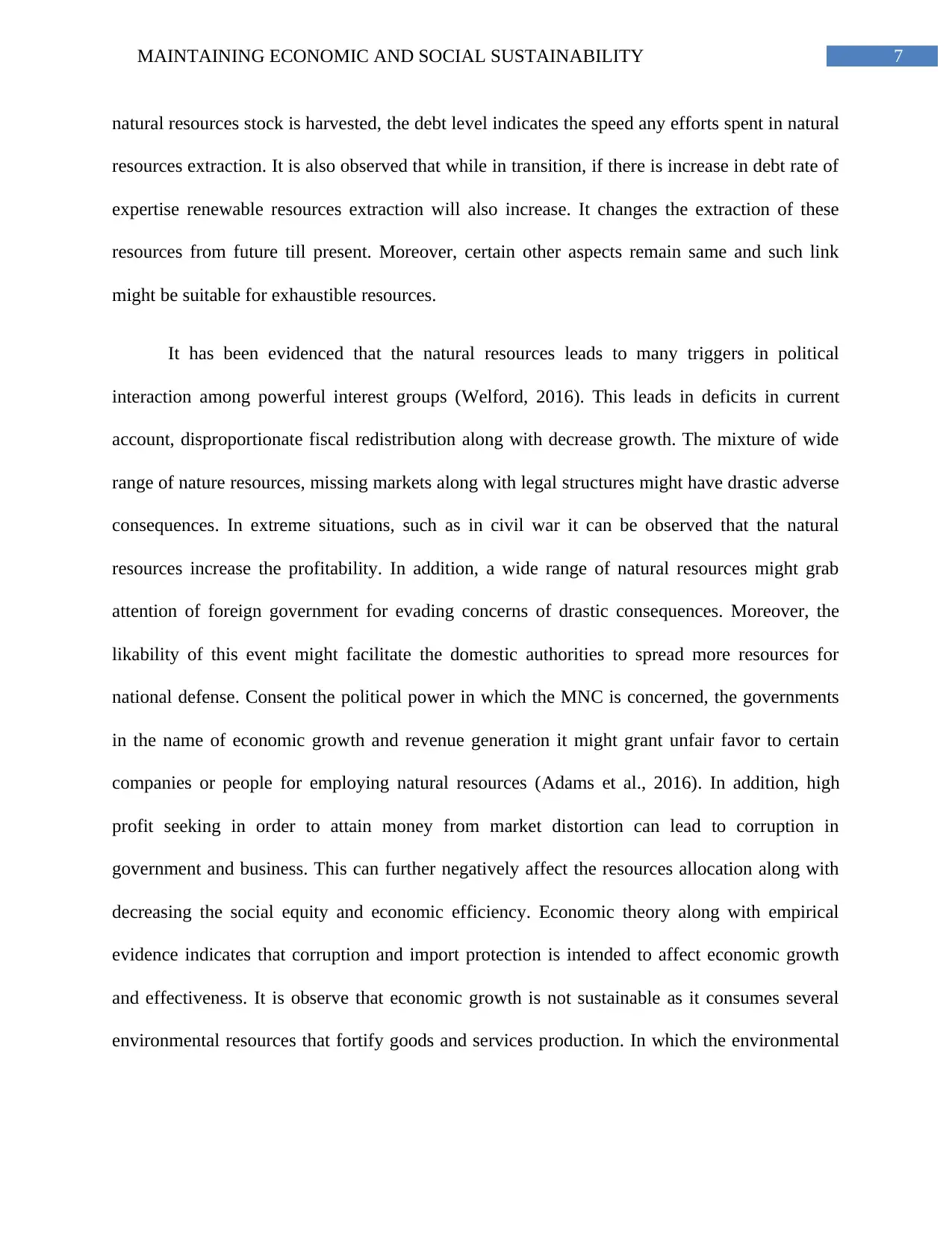
7MAINTAINING ECONOMIC AND SOCIAL SUSTAINABILITY
natural resources stock is harvested, the debt level indicates the speed any efforts spent in natural
resources extraction. It is also observed that while in transition, if there is increase in debt rate of
expertise renewable resources extraction will also increase. It changes the extraction of these
resources from future till present. Moreover, certain other aspects remain same and such link
might be suitable for exhaustible resources.
It has been evidenced that the natural resources leads to many triggers in political
interaction among powerful interest groups (Welford, 2016). This leads in deficits in current
account, disproportionate fiscal redistribution along with decrease growth. The mixture of wide
range of nature resources, missing markets along with legal structures might have drastic adverse
consequences. In extreme situations, such as in civil war it can be observed that the natural
resources increase the profitability. In addition, a wide range of natural resources might grab
attention of foreign government for evading concerns of drastic consequences. Moreover, the
likability of this event might facilitate the domestic authorities to spread more resources for
national defense. Consent the political power in which the MNC is concerned, the governments
in the name of economic growth and revenue generation it might grant unfair favor to certain
companies or people for employing natural resources (Adams et al., 2016). In addition, high
profit seeking in order to attain money from market distortion can lead to corruption in
government and business. This can further negatively affect the resources allocation along with
decreasing the social equity and economic efficiency. Economic theory along with empirical
evidence indicates that corruption and import protection is intended to affect economic growth
and effectiveness. It is observe that economic growth is not sustainable as it consumes several
environmental resources that fortify goods and services production. In which the environmental
natural resources stock is harvested, the debt level indicates the speed any efforts spent in natural
resources extraction. It is also observed that while in transition, if there is increase in debt rate of
expertise renewable resources extraction will also increase. It changes the extraction of these
resources from future till present. Moreover, certain other aspects remain same and such link
might be suitable for exhaustible resources.
It has been evidenced that the natural resources leads to many triggers in political
interaction among powerful interest groups (Welford, 2016). This leads in deficits in current
account, disproportionate fiscal redistribution along with decrease growth. The mixture of wide
range of nature resources, missing markets along with legal structures might have drastic adverse
consequences. In extreme situations, such as in civil war it can be observed that the natural
resources increase the profitability. In addition, a wide range of natural resources might grab
attention of foreign government for evading concerns of drastic consequences. Moreover, the
likability of this event might facilitate the domestic authorities to spread more resources for
national defense. Consent the political power in which the MNC is concerned, the governments
in the name of economic growth and revenue generation it might grant unfair favor to certain
companies or people for employing natural resources (Adams et al., 2016). In addition, high
profit seeking in order to attain money from market distortion can lead to corruption in
government and business. This can further negatively affect the resources allocation along with
decreasing the social equity and economic efficiency. Economic theory along with empirical
evidence indicates that corruption and import protection is intended to affect economic growth
and effectiveness. It is observe that economic growth is not sustainable as it consumes several
environmental resources that fortify goods and services production. In which the environmental
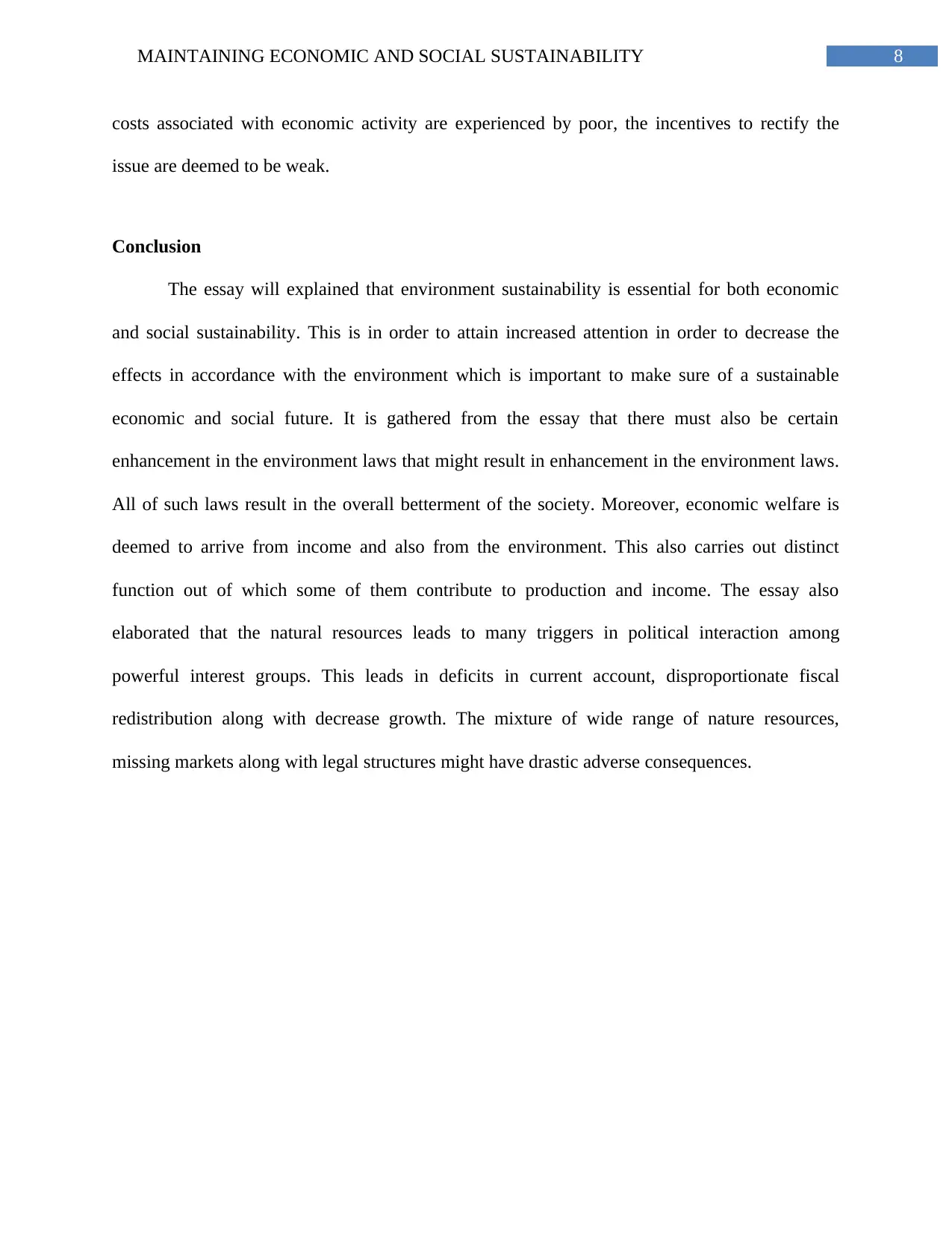
8MAINTAINING ECONOMIC AND SOCIAL SUSTAINABILITY
costs associated with economic activity are experienced by poor, the incentives to rectify the
issue are deemed to be weak.
Conclusion
The essay will explained that environment sustainability is essential for both economic
and social sustainability. This is in order to attain increased attention in order to decrease the
effects in accordance with the environment which is important to make sure of a sustainable
economic and social future. It is gathered from the essay that there must also be certain
enhancement in the environment laws that might result in enhancement in the environment laws.
All of such laws result in the overall betterment of the society. Moreover, economic welfare is
deemed to arrive from income and also from the environment. This also carries out distinct
function out of which some of them contribute to production and income. The essay also
elaborated that the natural resources leads to many triggers in political interaction among
powerful interest groups. This leads in deficits in current account, disproportionate fiscal
redistribution along with decrease growth. The mixture of wide range of nature resources,
missing markets along with legal structures might have drastic adverse consequences.
costs associated with economic activity are experienced by poor, the incentives to rectify the
issue are deemed to be weak.
Conclusion
The essay will explained that environment sustainability is essential for both economic
and social sustainability. This is in order to attain increased attention in order to decrease the
effects in accordance with the environment which is important to make sure of a sustainable
economic and social future. It is gathered from the essay that there must also be certain
enhancement in the environment laws that might result in enhancement in the environment laws.
All of such laws result in the overall betterment of the society. Moreover, economic welfare is
deemed to arrive from income and also from the environment. This also carries out distinct
function out of which some of them contribute to production and income. The essay also
elaborated that the natural resources leads to many triggers in political interaction among
powerful interest groups. This leads in deficits in current account, disproportionate fiscal
redistribution along with decrease growth. The mixture of wide range of nature resources,
missing markets along with legal structures might have drastic adverse consequences.
⊘ This is a preview!⊘
Do you want full access?
Subscribe today to unlock all pages.

Trusted by 1+ million students worldwide
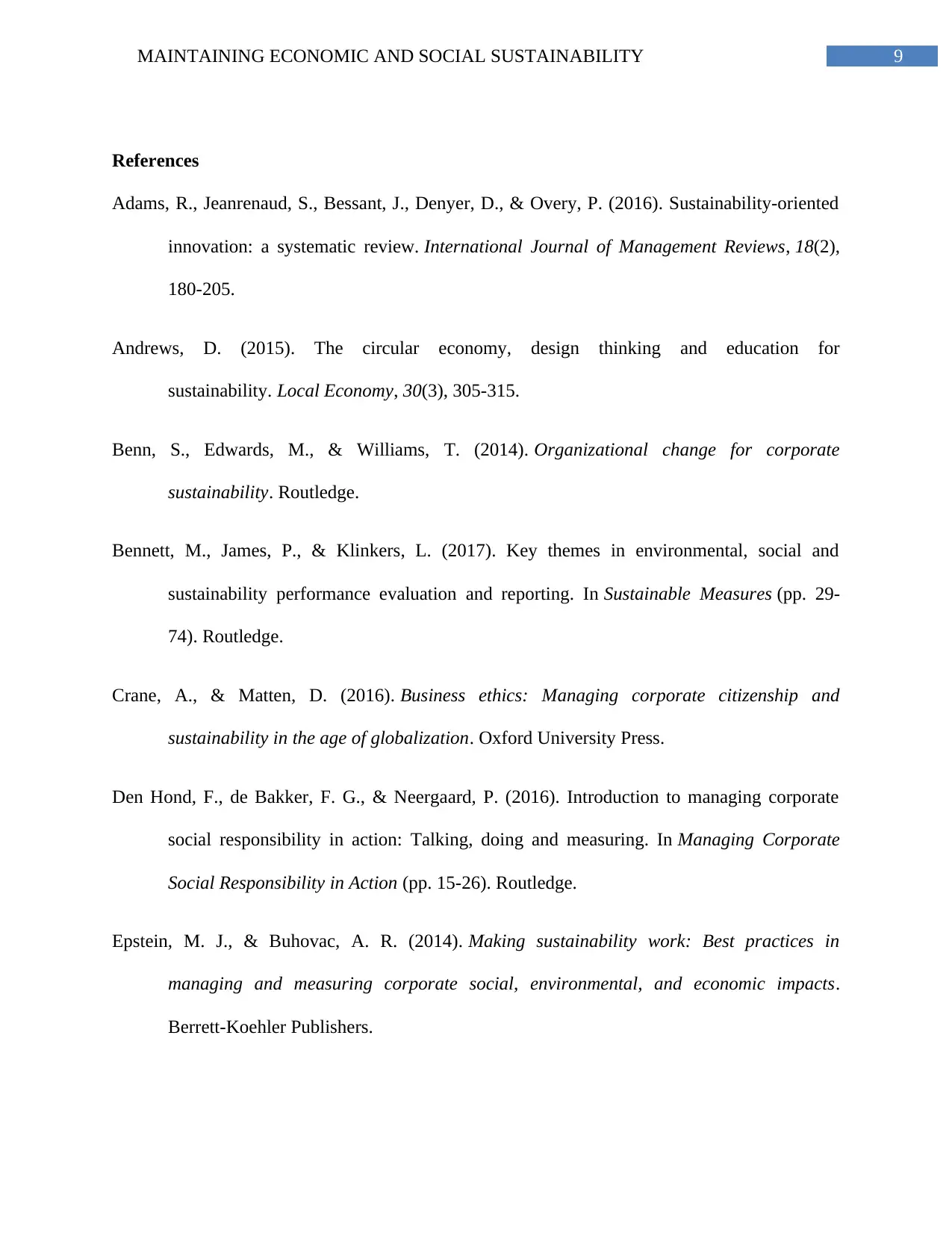
9MAINTAINING ECONOMIC AND SOCIAL SUSTAINABILITY
References
Adams, R., Jeanrenaud, S., Bessant, J., Denyer, D., & Overy, P. (2016). Sustainability‐oriented
innovation: a systematic review. International Journal of Management Reviews, 18(2),
180-205.
Andrews, D. (2015). The circular economy, design thinking and education for
sustainability. Local Economy, 30(3), 305-315.
Benn, S., Edwards, M., & Williams, T. (2014). Organizational change for corporate
sustainability. Routledge.
Bennett, M., James, P., & Klinkers, L. (2017). Key themes in environmental, social and
sustainability performance evaluation and reporting. In Sustainable Measures (pp. 29-
74). Routledge.
Crane, A., & Matten, D. (2016). Business ethics: Managing corporate citizenship and
sustainability in the age of globalization. Oxford University Press.
Den Hond, F., de Bakker, F. G., & Neergaard, P. (2016). Introduction to managing corporate
social responsibility in action: Talking, doing and measuring. In Managing Corporate
Social Responsibility in Action (pp. 15-26). Routledge.
Epstein, M. J., & Buhovac, A. R. (2014). Making sustainability work: Best practices in
managing and measuring corporate social, environmental, and economic impacts.
Berrett-Koehler Publishers.
References
Adams, R., Jeanrenaud, S., Bessant, J., Denyer, D., & Overy, P. (2016). Sustainability‐oriented
innovation: a systematic review. International Journal of Management Reviews, 18(2),
180-205.
Andrews, D. (2015). The circular economy, design thinking and education for
sustainability. Local Economy, 30(3), 305-315.
Benn, S., Edwards, M., & Williams, T. (2014). Organizational change for corporate
sustainability. Routledge.
Bennett, M., James, P., & Klinkers, L. (2017). Key themes in environmental, social and
sustainability performance evaluation and reporting. In Sustainable Measures (pp. 29-
74). Routledge.
Crane, A., & Matten, D. (2016). Business ethics: Managing corporate citizenship and
sustainability in the age of globalization. Oxford University Press.
Den Hond, F., de Bakker, F. G., & Neergaard, P. (2016). Introduction to managing corporate
social responsibility in action: Talking, doing and measuring. In Managing Corporate
Social Responsibility in Action (pp. 15-26). Routledge.
Epstein, M. J., & Buhovac, A. R. (2014). Making sustainability work: Best practices in
managing and measuring corporate social, environmental, and economic impacts.
Berrett-Koehler Publishers.
Paraphrase This Document
Need a fresh take? Get an instant paraphrase of this document with our AI Paraphraser
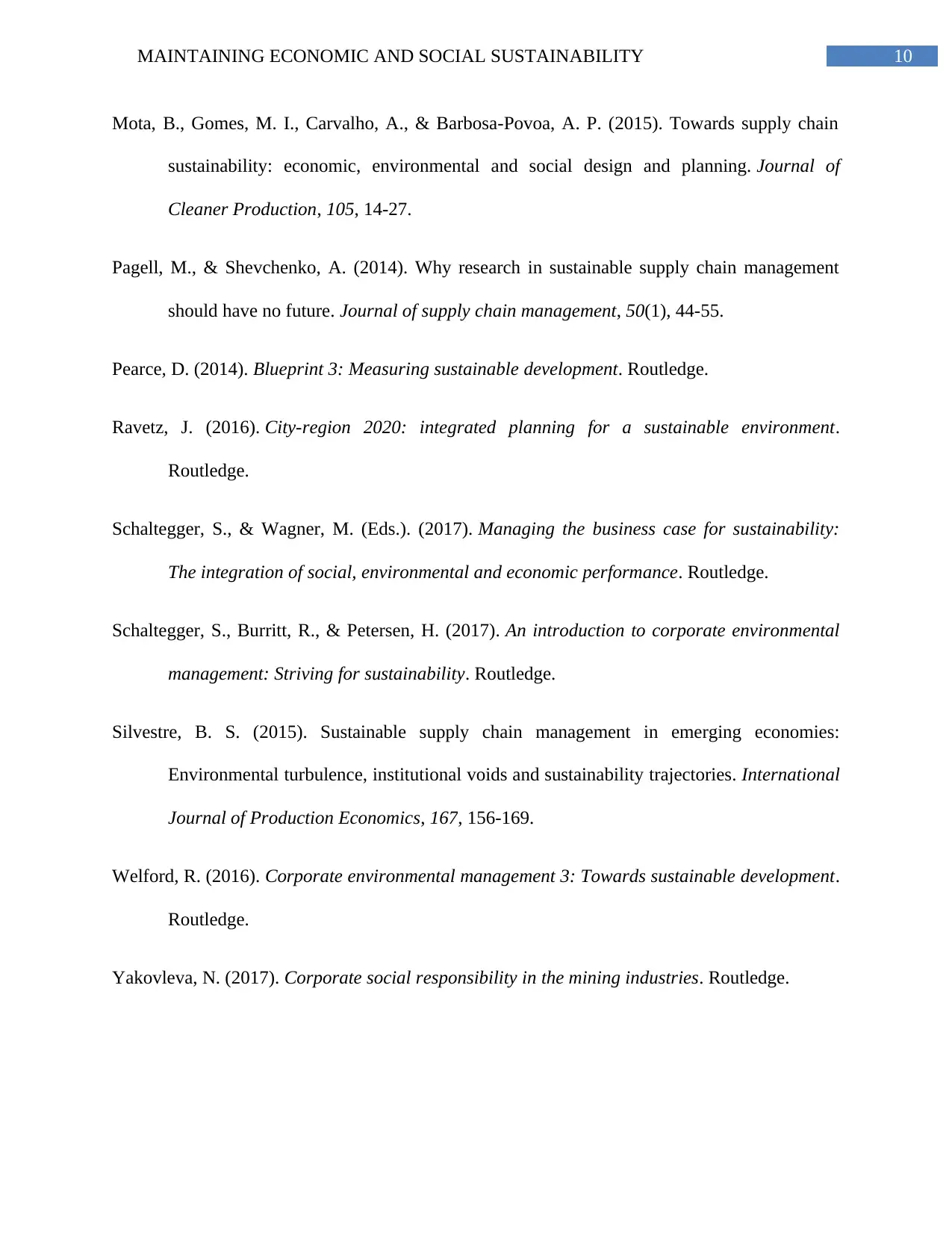
10MAINTAINING ECONOMIC AND SOCIAL SUSTAINABILITY
Mota, B., Gomes, M. I., Carvalho, A., & Barbosa-Povoa, A. P. (2015). Towards supply chain
sustainability: economic, environmental and social design and planning. Journal of
Cleaner Production, 105, 14-27.
Pagell, M., & Shevchenko, A. (2014). Why research in sustainable supply chain management
should have no future. Journal of supply chain management, 50(1), 44-55.
Pearce, D. (2014). Blueprint 3: Measuring sustainable development. Routledge.
Ravetz, J. (2016). City-region 2020: integrated planning for a sustainable environment.
Routledge.
Schaltegger, S., & Wagner, M. (Eds.). (2017). Managing the business case for sustainability:
The integration of social, environmental and economic performance. Routledge.
Schaltegger, S., Burritt, R., & Petersen, H. (2017). An introduction to corporate environmental
management: Striving for sustainability. Routledge.
Silvestre, B. S. (2015). Sustainable supply chain management in emerging economies:
Environmental turbulence, institutional voids and sustainability trajectories. International
Journal of Production Economics, 167, 156-169.
Welford, R. (2016). Corporate environmental management 3: Towards sustainable development.
Routledge.
Yakovleva, N. (2017). Corporate social responsibility in the mining industries. Routledge.
Mota, B., Gomes, M. I., Carvalho, A., & Barbosa-Povoa, A. P. (2015). Towards supply chain
sustainability: economic, environmental and social design and planning. Journal of
Cleaner Production, 105, 14-27.
Pagell, M., & Shevchenko, A. (2014). Why research in sustainable supply chain management
should have no future. Journal of supply chain management, 50(1), 44-55.
Pearce, D. (2014). Blueprint 3: Measuring sustainable development. Routledge.
Ravetz, J. (2016). City-region 2020: integrated planning for a sustainable environment.
Routledge.
Schaltegger, S., & Wagner, M. (Eds.). (2017). Managing the business case for sustainability:
The integration of social, environmental and economic performance. Routledge.
Schaltegger, S., Burritt, R., & Petersen, H. (2017). An introduction to corporate environmental
management: Striving for sustainability. Routledge.
Silvestre, B. S. (2015). Sustainable supply chain management in emerging economies:
Environmental turbulence, institutional voids and sustainability trajectories. International
Journal of Production Economics, 167, 156-169.
Welford, R. (2016). Corporate environmental management 3: Towards sustainable development.
Routledge.
Yakovleva, N. (2017). Corporate social responsibility in the mining industries. Routledge.
1 out of 11
Related Documents
Your All-in-One AI-Powered Toolkit for Academic Success.
+13062052269
info@desklib.com
Available 24*7 on WhatsApp / Email
![[object Object]](/_next/static/media/star-bottom.7253800d.svg)
Unlock your academic potential
Copyright © 2020–2025 A2Z Services. All Rights Reserved. Developed and managed by ZUCOL.





